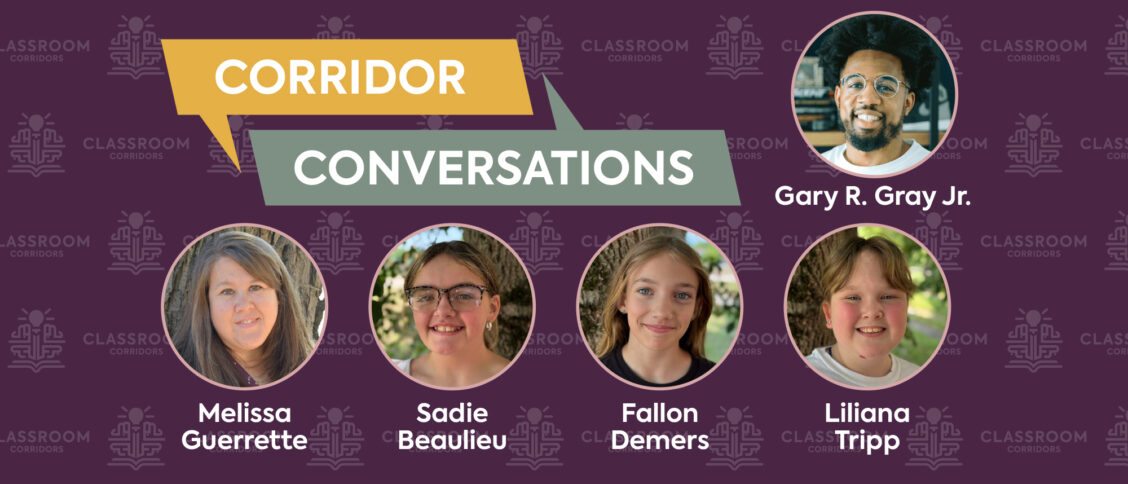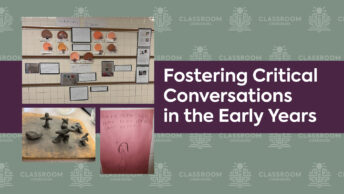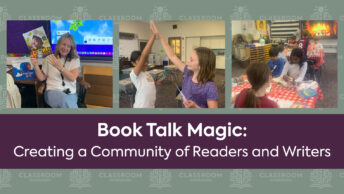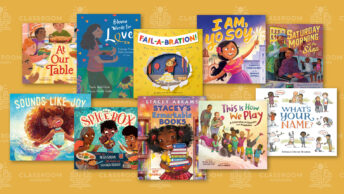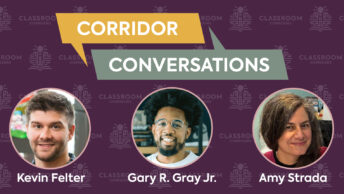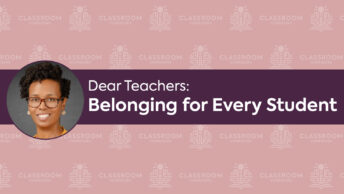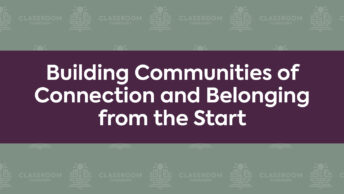This episode of Corridor Conversations is split between two sessions. In the first, host Gary R. Gray Jr. talks with three fifth-grade students, Sadie Beaulieu, Fallon Demers, and Liliana Tripp, about how connections were made and community was nurtured throughout the year in Melissa Guerrette’s classroom.
Would you rather read than listen? Download the transcript of the student conversation.
In the second segment. Melissa reflects on the students’ conversation and shares her ideas on creating a welcoming, respectful classroom environment.
Would you rather read than listen? Download the transcript of Melissa and Gary’s conversation.
In addition to her conversation with Gary, Melissa also offers the following reflections on what she learned from this podcast experience.
Looking Back . . . and Going Forward
In June, as the days with my fifth graders were dwindling, I was given a special opportunity to include my students’ voices in a professional development piece. We started out with a plan to talk with some of my students, and I expected to be part of the conversation. But, when Gary opened the conversation, the students had a lot to say, and in actuality, I said very little. I didn’t know the gift this would be at the time, but when we wrapped up their conversation with Gary, I felt proud of my students and what we had accomplished together, humbled by their evidence of learning, and—in a sense—reinvigorated about my why, even as I knew I needed rest before a new school year came again.
The conversation captured in this podcast is authentic and unscripted. It’s imperfect and unrefined. And, it has given me lots of feedback to use as I plan the beginning of a new school year with a new community of learners. Here are three intentional choices from the beginning of the school year that reverberated in the students’ conversation (or not), some areas for growth I’m thinking about, and how the time the students spent “looking back” is helping me with “going forward.”
Identity Maps
I learned about the activity of creating identity maps in a Heinemann workshop with Sara K. Ahmed several years ago. I devote time to unpacking identity and making identity maps during the first weeks of school each year. Discussion about identity says: I embrace this—YOU—and it’s ok to talk about and share these things here. When we begin mapping, I always go first. I prompt the students to listen with their eyes while I start to build my identity map on chart paper. Inevitably, the students begin to puzzle and hypothesize about what some parts mean or represent. I might speak to some of their curiosities, but I never finish completely. Many of the students’ identity maps begin with parallels to my map. While they create, I refer them back to categories and examples we’ve brainstormed together. I never push students to share beyond their comfort; I consider this activity to be an invitation to share themselves with each other and me. I add to my map while the students are working. This lets me model that an identity map takes time to develop and that their ideas can inspire me, too. Making and sharing our identity maps tells students I’m interested in all of what makes them who they are. By mapping with the students, I peel back the veil they see and allow them to get to know me beyond my teacher exterior while modeling vulnerability and building trust. For more information or examples, educators may want to dig into Sara’s book Being the Change: Lessons and Strategies to Teach Social Comprehension or visit Facing History and Ourselves for an example lesson plan, and you can see the identity maps made by our podcast guests here.
A Flood of Picturebooks
In the first weeks of school, I read between 6–8 picturebooks aloud to my students each week (and some of those are short weeks!). There are a few reasons for this. First, picturebooks serve as a springboard for conversations about social emotional skills and establishing expectations for respecting ourselves and others, taking responsibility for our actions, and keeping one another safe. Our picturebook discussions spark ideas as we co-construct classroom expectations. Discussing characters’ actions and feelings across texts, we begin shaping how we want to be treated and how we will cooperate and collaborate while sharing our learning space and experiences. My heart was lub-lubbing to hear the girls allude to accepting differences and exercising their empathetic muscles, validation of what I center in building and growing community, in the classroom and (hopefully!) beyond. For example, Sadie mentioned The Day You Begin as a text she remembered starting the year with (we did, on day one) and the message that even with our differences, we can get to know each other and find we have lots in common. The students also referred to Adrian Simcox Does Not Have a Horse as a text we shared that prompted discussions about empathy and handling big feelings. My Friend Maggie is a perennial favorite for students about navigating friendships and competition between friends, and it introduces students to what it means to be an upstander. Some other books I’ll use again or introduce this year are:
- The Cot in the Living Room by Hilda Eunice Burgos and Gaby D’Alessandro (perspective taking, empathy)
- Dr. Fauci: How a Boy from Brooklyn Became America’s Doctor by Kate Messner & Alexandra Bye (perseverance, problem solving)
- Do You Even Know Me by Reem Faruqi and Ani Bushry (agency, assertive communication)
- Ready to Soar by Cori Doerrfeld (self-confidence, what to do with feedback)
- What I Am by Divya Srinivasan (identity, individuality)
Listening to Sadie and Lily talk about analyzing picturebooks and reading deeply gave me insight about how they have grown as readers. A lot of what they shared with Gary is implicit learning that came from enthusiastically sharing my love and appreciation of books and their creators with students when we share texts. This is also something that begins from day one. Though fifth graders are sometimes believed to have outgrown picturebooks, these students talked with confidence and ease about what they have learned through instruction steeped in picturebooks. There is so much richness in teaching with picturebooks, and they are less intimidating for many of my beginning-of-year students. Reading, discussing, and analyzing picturebooks allows me to flood my students with shared story experiences early in the year that give us common ground that we will anchor back to.
Low-Stakes Writing
The students said little about our writing community. I wondered if they didn’t remember beginning the year with lots of writing time spent in generative exercises, depositing low-stakes quick writes in our new writing notebooks. Our first weeks of writing workshop includes constructing lists of all sorts: stories about favorite people and places, stories we associate with big feelings (like anger or embarrassment), and stories we may be reminded of by ordinary items (e.g., a boat, a ball, a key). We also free write; my students write true accounts and fictional stories, experimenting with formats like graphic novel panels. All the while, I’m learning about my students through their writing engagement and in the content of their lists. I come away from these days of exercises with information about which students are voluminous writers or writers with inhibition, who finishes quickly and who needs permission or encouragement to go deeper and who never gets to “the end.” I will continue to do this (even though it wasn’t mentioned by the students!) because I care deeply about supporting students’ identities as writers as much as I value helping them to express their ideas well. I want our writing workshop to support choice, ownership, agency, and student voice, so I begin to establish those characteristics quickly by giving students permission to make choices about their writing and validating their ideas as worthy of time, attention, and record, and . . . that writing is—first—for themselves. By keeping writing low-stakes at the start, I hope to de-emphasize the pressure of doing writing “right.”
Going Forward
Even as I found evidence in the students’ conversation to support continuing with these intentional design choices, I find myself thinking about the experience itself—the value of making space for students to talk about their learning and what stands out. I was fortunate that in Gary’s conversations with my students, I could listen for what they reflected back to me about their learning experiences. This leaves me planning forward into next year mindful of the value of listening to my students. I’m asking myself questions about how to make student feedback a more regular part of our community.
- Where in the school year would it make sense to slow down and let students share their perspectives and ideas?
- How could I build in time to invite my students, maybe in small groupings, to provide me feedback about our community, my practice, and lessons?
- How could I replicate this sort of invitation to share their thinking so that it doesn’t feel stilted or disingenuous?
Listening to my students reminded me that sometimes I need to get out of the way with my pre-planned activities, assessments, and general need to have it all together and just listen to my kids. They’ll offer me plenty to think about.
My overall observation about the conversation Gary had with my students was their confidence in talking about their experiences at school with him and with each other. They self-governed the conversation, trying to monitor air time and include each other in the conversation. They were kind and considerate, reflective and truthful. The conditions and climate we cultivated in the classroom together from the very first day yielded fertile ground for bountiful talk and acceptance of ourselves, others, and different perspectives. In what these students shared, I can find things to refine, like supporting reflection and leaving space for student voice. Even though I feel like I give my students air time, I could probably still say less and listen more. For students who joked about starting the year with me doing ALL the talking, they emerged as thoughtful minds who know their voice matters.
Our students grow and change in so many ways over the course of a single school year together, and every day matters. For these students and their classmates, establishing a strong community culture as literacy learners and as people was vital. Their memories and reflections assure me that the time spent building relationships and making intentional choices makes a difference, and it energizes me to look forward to getting to know a new class of readers and writers soon.
Biographies
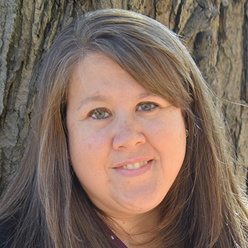
Melissa Guerrette (she/her) is a National Board Certified Teacher with 24 years of teaching experience in grades 4–6 at Oxford Elementary School in Maine. Melissa was named the 2025 Claudette and John Brassil Distinguished Educator by the Maine Council for English Language Arts. Melissa is involved with local and state initiatives related to reading communities, ELA curricula, school improvement, and teacher leadership. She is a member of the Teach Maine Center Design Team and was a lead consultant and contributor to the PINE Project Professional Development modules. Her professional passion is empowering students and helping them uncover their identities—as readers, as writers, and as people—for themselves. You can find Melissa on Bluesky or Instagram at @msguerrette, or via email at nbct.melissa@gmail.com.
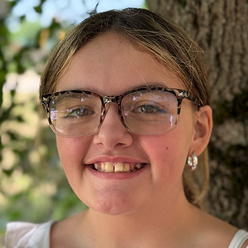
Sadie Beaulieu is a rising sixth grader at Oxford Elementary School in Maine. Sadie is a reader, an artist, and always a kind and encouraging friend. She enjoys spending time with her family, making art, and playing the violin.
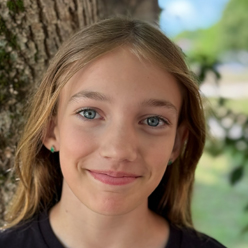
Fallon Demers is a rising sixth grader at Oxford Elementary School in Maine. Fallon is an artist and an athlete. She is an insightful reader, a creative writer, and a good advocate for herself and others. Her classmates appreciate her leadership.
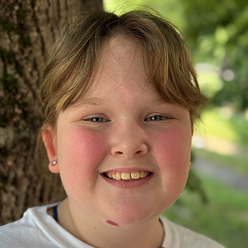
Liliana Tripp is a rising sixth grader at Oxford Elementary School in Maine. Liliana enjoys singing, playing piano, dancing, and reading. Liliana is an articulate writer and speaker. She actively serves her community through her own nonprofit, From Lil With Love.

